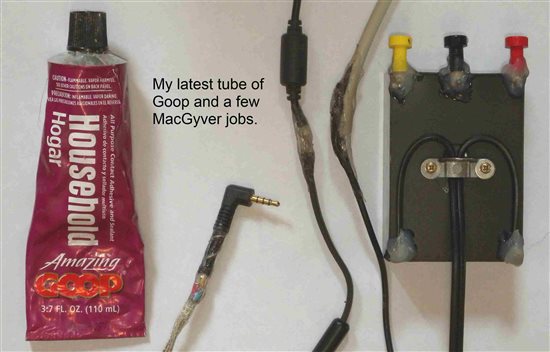A holiday week is a good excuse to stray a bit off topic so this is my chance to tell you about Goop. It is by far the most versatile glue I’ve found. Okay, I promise to tie this in (though weakly) to electronics. Goop comes in a fat toothpaste tube and squeezes out clear with the consistency of molasses. It sticks to most anything, fills voids, sets up in an hour or two and cures overnight. Unlike epoxy, there’s no mixing, it’s slightly compliant (not brittle) and cleans off your fingers just by rubbing.
In my family, my use of Goop is legendary. Depending on the results, their comments range from praise to ridicule.
There are countless household uses but I need to tie this to electronics. I have improvised or repaired many electrical plugs, adapters, chargers, wall warts, etc. from my extensive salvaged junk collection (my son calls them my starship parts). Fragile soldered connections are embedded in Goop for mechanical strength, strain relief and insulation. It generally takes a two or three layers to fully cover a splice like shown below. Try it next time you need to make an adaptor or fix a broken connector.
My son-in-law calls these “MacGyver jobs” and treasures the MacGyver charger and MacGyver microphones fashioned for his special needs. My son thinks I’m nuts.
I owe another connection to our integrated circuit business: You can find Goop branded several ways—Household Goop, Plumber’s Goop, Automotive Goop and Marine Goop. In big box stores you’ll find the differently branded versions in different departments. But I came across Goop in my friendly hardware store and all four types were hanging in one location, all with different prices. (Stay with me… I’ll make a connection, here.) I did some searching. Maybe there are small differences in the various versions, I’m not sure. Household Goop is the cheapest. Marine Goop is the most expensive (not too surprising). If they made aeronautical Goop I bet it would be even more expensive. Maybe it’s just marketing, I don’t know.
You may be aware that we do similar rebranding of integrated circuits. I’ve been involved in rebranding of the same IC, for example, to serve both industrial and audio markets. I’ll assure you that there are reasons, however, for differences in pricing. The testing is different and the yields are different. DC accuracy specs are not so important for audio applications so we can relax our test limits on offset voltage, drift and other tricky specs that may affect our yields and test time. In some cases, packaging techniques may be slightly different with compliant chip coatings to reduce stress that can cause offset and drift. There are real cost differences.
There is a marketing angle, too. Different data sheets can bring focus to the specs, issues and applications that are important for the intended market. We can use language and descriptions that are familiar to the engineers working in that industry. For you, this has real value.
Now, back to Goop. I do a lot of MacGyvering in electronics and many other household jobs. I keep my Goop handy but I’m always looking for better stuff. If you’ve found a particularly useful MacGyvering trick, glue or otherwise, you need to share it with all of us.
Thanks for reading and I look forward to your suggestions.
Bruce
p.s. My other favorite MacGyvering media include cardboard and defunct bicycle tubes.

